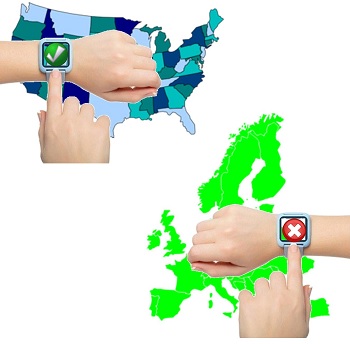A new report issued by Forrester Research has indicated that there will be a tripling of wearables users in 2015.
According to Forrester Research in a new report that they have recently released, the number of people who will be using wearable technology is going to triple throughout next year, when compared to this year’s figures.
This will, said the report, be greatly driven by the upcoming release of the Apple Watch, early next year.
The research firm has predicted that the Apple Watch, alone, will draw an additional 10 million users to the wearable technology category. This represents a more rapid growth rate than has been issued by a number of other forecasts, which feel as though the first wave of chunky, unfashionable, and just plain ugly prototypes and early generations of devices will have put many consumers off the idea for some time. But this new research indicates that next year will be a breakout for this trend.
That said, the interest in wearable technology was found to be greatly different between the U.S. and Europe.
 Polling data that was used in this Forrester Research study involved the participation of thousands of consumers throughout Europe and the United States. Among Americans 45 percent said that they could imagine themselves using wearables. That said, among Europeans, only 32 percent said that they would want to wear those devices.
Polling data that was used in this Forrester Research study involved the participation of thousands of consumers throughout Europe and the United States. Among Americans 45 percent said that they could imagine themselves using wearables. That said, among Europeans, only 32 percent said that they would want to wear those devices.
That said, within the wearables category, there are areas that consumers can picture themselves using more than others. For example, health monitors and smartwatches were among the items that consumers said that they were more likely to wear than other devices such as smart glasses. People seemed more willing to wear something on their wrists, followed by those that clip onto clothing. Lastly was those that were to be worn on the ear or face.
Even in the United States, there was a difference from one region to the next among the various categories of wearable technology. That said, in every area there were people who were willing to try everything from the aforementioned devices to smart jewelry, but even tech enhanced contact lenses and tattoos had some willing adopters.
Recent research has revealed that while wearables are drawing interest, most won’t pay over $300 for them.
It is becoming increasingly difficult to find an electronics and mobile devices maker that has not come up with its own version of wearable technology, but while recent studies have shown that many consumers are very interested in this tech, the price tag is creating a barrier to adoption.
Wearables are coming out in the form of everything from smartwatches to clothing, glasses, jewelry, and more.
Despite the fact that there are many different offerings within the wearable technology category, it is clearly an industry that remains in its infancy as companies have not yet come up with the strategy that will ensure that the majority consumers will be willing to buy these devices and like them enough that they will be willing to replace them as new generations of wearables are released. A recent PricewaterhouseCoopers (PwC) study has provided considerable insight into this struggle.
The research asked 1,000 consumers in the United States about their opinions with regards to wearable technology.
 What it showed was that many Americans do already have one of these devices, at least in some form, and that they have high hopes with regards to their benefits. The data showed that around one in five people in the U.S. currently has some type of wearable technology device, such as a wrist band or a digital pedometer that will connect with their computers or smartphones.
What it showed was that many Americans do already have one of these devices, at least in some form, and that they have high hopes with regards to their benefits. The data showed that around one in five people in the U.S. currently has some type of wearable technology device, such as a wrist band or a digital pedometer that will connect with their computers or smartphones.
That said, a surprising 56 percent of the people who took part in the PwC study also felt that these mobile gadgets (more specifically, those that allow for bio-feedback such as fitness trackers, sleep trackers, and those that monitor heart rate) will help a person to boost his or her life expectancy by a decade. Equally, just under 42 percent of the participants believed that wearables could help an individual to boost his or her athletic ability and overall fitness level.
That said, while 21 percent of the participants actually own some form of wearable technology device, only 10 percent of the total respondents actually use their gadget on a daily basis. Moreover, there is a price limit to the amount that they would spend. Only 5 percent said that they would be willing to pay $300 for a device in this category, while even fewer – 4 percent – said that they would be willing to pay $500. Only time will reveal whether or not the $349 price tag of the Apple Watch will make that product cost prohibitive.
 Polling data that was used in this Forrester Research study involved the participation of thousands of consumers throughout Europe and the United States. Among Americans 45 percent said that they could imagine themselves using wearables. That said, among Europeans, only 32 percent said that they would want to wear those devices.
Polling data that was used in this Forrester Research study involved the participation of thousands of consumers throughout Europe and the United States. Among Americans 45 percent said that they could imagine themselves using wearables. That said, among Europeans, only 32 percent said that they would want to wear those devices.
 What it showed was that many Americans do already have one of these devices, at least in some form, and that they have high hopes with regards to their benefits. The data showed that around one in five people in the U.S. currently has some type of wearable technology device, such as a wrist band or a digital pedometer that will connect with their computers or smartphones.
What it showed was that many Americans do already have one of these devices, at least in some form, and that they have high hopes with regards to their benefits. The data showed that around one in five people in the U.S. currently has some type of wearable technology device, such as a wrist band or a digital pedometer that will connect with their computers or smartphones.